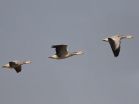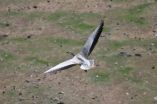(Press-News.org) A new study into how the world's highest flying bird, the bar-headed goose, is able to survive at extreme altitudes may have future implications for low oxygen medical conditions in humans.
An international team of scientists recently tracked the bar-headed goose while it migrated across the Himalayas. Now they have shown how these birds are able to tolerate running at top speed while breathing only 7% oxygen.
Exercising at high altitude is a massive challenge since at the top of the highest mountains the air is only made up of 7% oxygen, compared with 21% at sea level. This is why human climbers often use supplemental oxygen when scaling the world's tallest peaks.
Dr Lucy Hawkes of the University of Exeter led the study, along with colleagues Dr Charles Bishop (Bangor University) and Prof. Pat Butler (University of Birmingham). They tested how good the geese were at coping with exercise in reduced oxygen environments by simulating the conditions of Mount Everest in a clear box and then getting the birds to run as fast as possible on a treadmill inside the box.
They discovered that the geese had a remarkable tolerance of low oxygen conditions – at rest and while they were exercising for 15 minutes at top speed – at oxygen levels that would render most humans completely immobile. The researchers also conducted the experiments with the barnacle goose, which migrates at sea-level, and found that they did not have the same ability in low oxygen conditions.
Dr Lucy Hawkes, of the Centre for Ecology and Conservation at the University of Exeter's Penryn Campus, said: "It all seems to come down to how much oxygen bar-headed geese can supply to their heart muscles. The more they can supply, the faster they can beat their hearts and keep the supply of oxygen to the rest of the body going. This suggests that other species, including humans, are limited more by what our hearts can do than by how fit the rest of our muscle are at altitude."
Dr Hawkes, formerly of Bangor University, added: "The wider implications of these findings are for low oxygen medical conditions in humans, such as heart attack and stroke – suggesting what adaptations might help prevent problems in the first place and learning how animals have managed to cope with really extreme environments."
Bar-headed geese and barnacle geese undertake similar long distance migratory flights between breeding and wintering grounds, usually covering thousands of miles, during the autumn and spring. Bar-headed geese travel from Indian wintering grounds and high Asian breeding grounds in China and Mongolia, which means that they have to cross the Himalayan Mountains en route while flying as high as 7,290m (23,917ft).
The animals have been shown to possess a number of specific physiological adaptations that may increase their performance relative to other species of geese when exposed to severe environmental hypoxia (inadequate oxygen supply). In particular, their heart and locomotor muscles contain more blood vessels.
INFORMATION:
Geese ran on treadmills in simulated high altitude conditions
Results show 'remarkable tolerance' to low oxygen
Researchers say findings could help study of heart attacks and stroke
The study received funding from the Biotechnology and Biological Sciences Research Council (BBSRC).
The article, 'Maximum running speed of captive bar-headed geese is unaffected by severe hypoxia' by Lucy A Hawkes, Patrick J Butler, Peter B Frappell, Jessica U Meir, William K Milsom, Graham R Scott & Charles M Bishop is published today (April 7) in the journal PLOS ONE.
A video animation to accompany the release is available at: http://youtu.be/c5miFi0ASJc
Running geese give insight into low oxygen tolerance
2014-04-08
ELSE PRESS RELEASES FROM THIS DATE:
Faster eye responses in Chinese people not down to culture
2014-04-08
New research from University of Liverpool scientists has cast doubt on the theory that neurological behaviour is a product of culture in people of Chinese origin.
Scientists tested three groups – students from mainland China, British people with Chinese parents and white British people – to see how quickly their eyes reacted to dots appearing in the periphery of their vision.
These rapid eye movements, known as saccades, were timed in all of the participants to see which of them were capable of making high numbers of express saccades – particularly fast responses which ...
For good and ill, immune response to cancer cuts both ways
2014-04-07
The difference between an immune response that kills cancer cells and one that conversely stimulates tumor growth can be as narrow as a "double-edged sword," report researchers at the University of California, San Diego School of Medicine in the April 7, 2014 online issue of the Proceedings of the National Academy of Sciences.
"We have found that the intensity difference between an immune response that stimulates cancer and one that kills it may not be very much," said principal investigator Ajit Varki, MD, Distinguished Professor of Medicine and Cellular and Molecular ...
Genetic predisposition to liking amphetamine reduces risk of schizophrenia and ADHD
2014-04-07
Genetic variants associated with enjoying the effects of d-amphetamine—the active ingredient in Adderall—are also associated with a reduced risk for developing schizophrenia and attention deficit hyperactivity disorder (ADHD), report scientists from the University of Chicago in the Proceedings of the National Academy of Sciences on April 7. The results support a long-standing hypothesis that dopamine, the neurotransmitter connected with the euphoric effects of amphetamine, is related to schizophrenia and ADHD.
"Some of the variants that make you like amphetamine also ...
Scientists find missing piece of air particle equation hiding in the walls
2014-04-07
Laboratory chamber walls have been stealing vapors, causing
researchers to underestimate the formation of secondary organic
aerosol in the atmosphere.
A study published April 7 in PNAS Online Early Edition describes how
a team of scientists, including researchers from the University of
California, Davis, showed that vapor losses to the walls of
laboratory chambers can suppress the formation of secondary organic
aerosol, which in turn has contributed to the underprediction of SOA
in climate and air quality models.
SOA impacts air quality and climate and makes ...
Scientists identify part of brain linked to gambling addiction
2014-04-07
New research reveals that brain damage affecting the insula – an area with a key role in emotions – disrupts errors of thinking linked to gambling addiction. The research, led by Dr Luke Clark from the University of Cambridge, was published today, 07 April, in the journal PNAS.
During gambling games, people often misperceive their chances of winning due to a number of errors of thinking called cognitive distortions. For example, 'near-misses' seem to encourage further play, even though they are no different from any other loss. In a random sequence like tossing a coin, ...
New light shed on key bacterial immune system
2014-04-07
New insights into a surprisingly flexible immune system present in bacteria for combating viruses and other foreign DNA invaders have been revealed by researchers from New Zealand's University of Otago and the Netherlands.
A team led by Dr Peter Fineran of the Department of Microbiology and Immunology are studying the genetic basis of adaptive immunity in bacteria that cause potato 'soft rot' and in E. coli bacteria. Through their recent collaboration they have found that these bacterial immune systems are much more robust and responsive than previously thought.
Their ...
Genes increase the stress of social disadvantage for some children
2014-04-07
Genes amplify the stress of harsh environments for some children, and magnify the advantage of supportive environments for other children, according to a study that's one of the first to document how genes interacting with social environments affect biomarkers of stress.
"Our findings suggest that an individual's genetic architecture moderates the magnitude of the response to external stimuli—but it is the environment that determines the direction" says Colter Mitchell, lead author of the paper and a researcher at the University of Michigan Institute for Social Research ...
Targeting sperm protection in mosquitoes could help combat malaria
2014-04-07
Researchers have discovered a way of reducing the fertility of malaria-carrying mosquitoes, potentially providing a new tactic to combat the disease.
Anopheles gambiae mosquitoes are the main transmitters of malaria, which affects around 200 million people every year. The females mate only once during their lives. They store the sperm from this single mating in an organ called the spermatheca, from which they repeatedly take sperm over the course of their lifetime to fertilise the eggs that they lay..
The female needs the sperm to stay healthy whilst they are in storage ...
Solution to platelet 'puzzle' uncovers blood disorder link
2014-04-07
Melbourne researchers have solved a puzzle as to how an essential blood-making hormone stimulates production of the blood clotting cells known as platelets.
Platelets are essential for stopping bleeding and are produced by small fragments breaking off their 'parent' cells, called megakaryocytes.
The discovery, made by scientists at the Walter and Eliza Hall Institute, identified how bone marrow cells could become overstimulated and produce too many platelets. In blood diseases such as essential thrombocythemia, too many platelets can lead to clogging of the blood vessels, ...
Seeing double: New study explains evolution of duplicate genes
2014-04-07
From time to time, living cells will accidently make an extra copy of a gene during the normal replication process. Throughout the history of life, evolution has molded some of these seemingly superfluous genes into a source of genetic novelty, adaptation and diversity. A new study shows one way that some duplicate genes could have long-ago escaped elimination from the genome, leading to the genetic innovation seen in modern life.
Researchers have shown that a process called DNA methylation can shield duplicate genes from being removed from the genome during natural selection. ...



